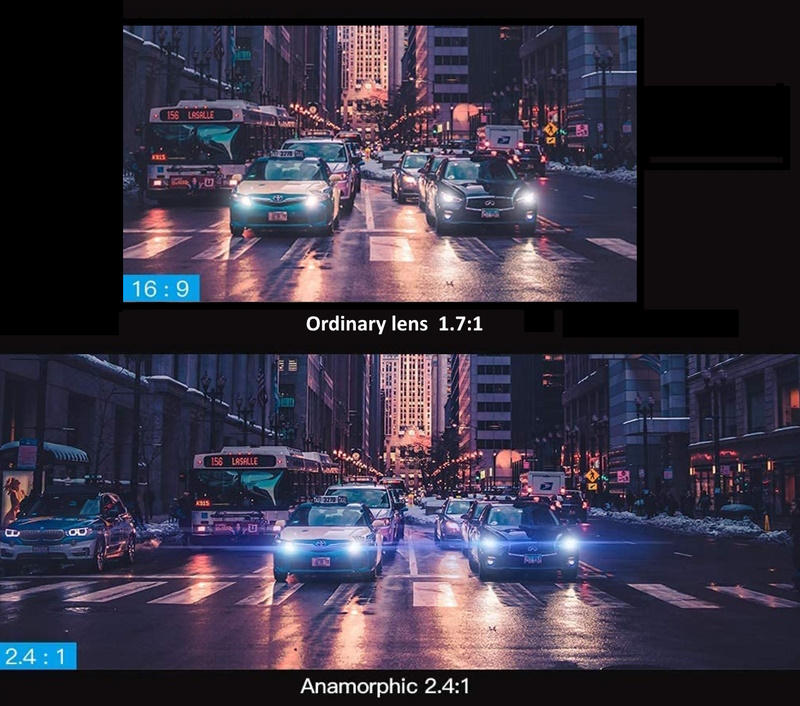Anamorphic lenses are a type of lens that produces a stretched image when projected onto a screen. The primary usage of anamorphic lenses is in the film industry, where they are used to create a widescreen effect. Anamorphic lenses have been used in movies for decades, and they have become an essential tool for filmmakers who want to produce a cinematic look for their films. The use of anamorphic lenses can be seen in some of the most iconic films of all time, such as Star Wars, The Godfather, and Jaws.
In this article, we will explore what anamorphic lenses are, their advantages and disadvantages, and the different types available.
But, before we proceed, we need to explain some terms:
Aspect ratio
The video aspect ratio is the video width in proportion to the height. This ratio describes how wide your video is.

There are several common aspect ratios for videos, including:
- 4:3 – This was the standard aspect ratio for television sets until the 2000s. It is also commonly used for some digital cameras and mobile devices.
- 16:9 – This is the most common aspect ratio for modern television sets, computer monitors, and video content on the internet, including YouTube and Vimeo.
- 85:1 – This is a widescreen aspect ratio commonly used for feature films. It is slightly wider than the 16:9 aspect ratio.
- 35:1 – This is a very wide aspect ratio used for some feature films. It is also known as “Cinemascope” and provides an even wider viewing experience than 1.85:1.
- 21:9 – This is an ultra-wide aspect ratio that is becoming increasingly popular for computer monitors and some high-end televisions.
What is an anamorphic lens?
Anamorphic lenses are designed to optically squeeze the horizontal axis of an image by a certain factor called the squeeze factor while leaving the vertical axis unchanged.
This process creates an image that appears distorted or squeezed, but when projected onto a widescreen, it is de-squeezed to produce a wider aspect ratio. This process is also known as anamorphic compression.
The “squeeze factor” is the amount of optical squeeze applied by the anamorphic lens, and it is represented as a ratio between the width of the original image and the width of the squeezed image.
The use of an anamorphic lens allows capturing of an artificially widened field of view (FOV) with a standard 4:3 size sensor, then creates a wider aspect ratio in post-production without using a wide-angle lens.

Types of anamorphic lenses
There are many different types of anamorphic lenses commonly called ‘Scopes,’ each with a different strength squeeze (squeeze factor). These lenses with different squeeze factors will produce different images with distinct aspect ratios.
For instance, a 2x squeeze anamorphic lens will produce an image with a wider aspect ratio than a 1.33x squeeze anamorphic lens. This means that an image taken with a 2x squeeze anamorphic lens will have a more pronounced horizontal stretch compared to an image taken with a 1.33x squeeze anamorphic lens.
What are the characteristics of a video/movie shot with anamorphic lenses?
A video shot with anamorphic lenses will have several distinct characteristics that set it apart from videos shot with other types of lenses. Here are some of the primary characteristics of a video shot with anamorphic lenses:
-
Widescreen aspect ratio:
One of the most significant characteristics of a video shot with anamorphic lenses is the widescreen aspect ratio. Anamorphic lenses are designed to produce a stretched or distorted image that is de-squeezed to create a wider aspect ratio. The most common aspect ratios for anamorphic lenses are 2.39:1 and 2.40:1, which are wider than the standard 16:9 aspect ratio used for most television screens.

-
Increased field of view:
Anamorphic lenses capture a wider field of view than other types of lenses, which can be especially useful when shooting landscapes, cityscapes, or large groups of people. This increased field of view can create a more immersive and cinematic experience for the viewer.

-
Increased compression:
The result of an increased compression of the image is a shallower depth of field, which makes the background appear closer to the subject. This effect can be helpful in separating the subject from the background and creating a more cinematic look.

-
Bokeh:
Anamorphic lenses are known for their unique Bokeh, which is the aesthetic quality of the out-of-focus areas in an image. Anamorphic lenses produce a Bokeh that is oval or elliptical in shape, rather than the circular Bokeh produced by other types of lenses. This oval or elliptical Bokeh adds an extra layer of depth and dimension to the image, making it more visually appealing.

-
Lens flares:
Anamorphic lenses are also known for producing lens flares, which are the streaks of light that appear in an image when bright light sources are in the frame. Anamorphic lens flares are unique because they are stretched or elongated, rather than circular like other types of lens flares. These lens flares can add a dramatic and cinematic look to the image.

Advantages of using anamorphic lenses
There are several advantages to using anamorphic lenses. One of the most significant advantages is the ability to create a widescreen effect without having to crop the image.
When filmmakers use traditional lenses, they are forced to crop the image to achieve the desired aspect ratio. This process can result in the loss of important visual information that can affect the overall look and feel of the film.
Anamorphic lenses allow filmmakers to capture a wider field of view, which can be especially useful when shooting landscapes, cityscapes, or large groups of people.
Another advantage of anamorphic lenses is the unique look they produce. The stretched or distorted image creates a cinematic look that is instantly recognizable. This look can add an extra layer of depth and dimension to the film, making it more visually appealing and immersive for the audience.
Disadvantages of anamorphic lenses
However, anamorphic lenses also have some disadvantages. One of the most significant disadvantages is their cost. Anamorphic lenses can be expensive, which can be a barrier for filmmakers who are working on a tight budget.
Additionally, anamorphic lenses are heavier and bulkier than traditional lenses, which can make them more challenging to work with, especially when shooting on location.
Affordable anamorphic lenses
Anamorphic lenses are quite expensive because they are mainly designed for filmmakers, however, there are some brands offering anamorphic lenses for use with consumer DSLR and mirrorless cameras, such as:
SLR Magic produces a range of affordable anamorphic lenses for use with mirrorless and cinema cameras. Their lenses include the Anamorphot 1.33x-65, Anamorphot 1.33x-50, and Anamorphot 1.33x-40, which all offer different levels of anamorphic squeeze and are designed to be compact and lightweight.
Vazen is a newer lens manufacturer that specializes in anamorphic lenses for mirrorless cameras. Their anamorphic lenses include the 28mm T2.2, 40mm T2, and 65mm T2, which all feature a 1.8x anamorphic squeeze and are designed to be affordable, yet high-quality.
Sirui produces a range of affordable anamorphic lenses for use with mirrorless cameras and smartphones. Their lenses feature a 1.33x and 1.6x anamorphic squeeze and are designed to be lightweight and easy to use.
Sirui 24mm f/2.8 1.33x Anamorphic
This 24mm f/2.8 Anamorphic 1.33x Lens from Sirui, in a Sony E mount, brings a wide-angle feel to your anamorphic imagery, in addition to the extra width provided by the anamorphic process. Designed for MFT/APS-C cameras with a Sony E mount, the lens increases the horizontal FOV by 33% compared with traditional 24mm APS-C lenses. After de-squeezing, the captured image is displayed in a 2.4:1 format in a 16:9 setting. Lightweight and portable, the f/2.8 lens is designed with an aluminum housing and features optics with multilayer nano coatings.
SIRUI 50mm F1.8 1.33x APS-C Anamorphic
This 50mm f/1.8 Super35 Anamorphic 1.33x Lens from Sirui adds 1.33x anamorphic squeeze to your images to achieve standard 2.4:1 widescreen aspect ratios. Designed for Super35/APS-C cameras with a Canon RF mount, the lens features an aperture range of f/1.8 to f/16. Lens construction of 11 elements in 8 groups creates the characteristic, stretched oval bokeh of anamorphic lenses for a unique cinematic look.
The focus ring is capable of rotating at 143.6° for intuitive control. A 67mm filter thread allows you to add compatible filters and customize your exposure. Markings on the lens are in both feet and meters. When used with a full-frame sensor, the 50mm lens is equivalent to a 53mm lens horizontally.
SIRUI 50mm T2.9 1.6X Full-Frame Anamorphic
The Canon RF-mount 50mm T2.9 Anamorphic 1.6x Lens, from Sirui, is designed for filling a theater screen with rich detail, cinematic bokeh, and artistic lens flairs. One of the signature features of this lens is that it produces horizontal blue streaks when pointed at a light source, giving your footage a dreamy or science-fiction aesthetic. On full-frame cameras, this lens increases the horizontal angle of view by 60%, equivalent to a wider 31mm spherical lens, and it enables the camera to see well to the left and right of your subject. An image captured in 16:9 is de-squeezed to an anamorphic 2.8:1 aspect ratio, whereas shooting in 3:2 yields a 2.4:1 final image.
A key aspect of anamorphic lenses is oval bokeh, which can gently distort objects and lights in the distance, providing an abstract background for your actors. Its T2.9 aperture produces a shallow depth of field, blurring everything in front or behind the specifically chosen focal plane. It features female 1/4″-20 threading for mounting versatility, and its focus and aperture rings are geared for use with a follow focus system.
Important remark
It is important to mention that the compatibility of available lenses in the market with different cameras varies very much, so it’s important to check that the lens you choose will work with your specific camera before making a purchase.
Conclusion
Anamorphic lenses are a critical tool in the film industry, allowing filmmakers to create a widescreen effect without having to crop the image. The unique look they produce adds an extra layer of depth and dimension to the film, making it more visually appealing and immersive for the audience.
The good news is that enthused photographers can now afford to have the same astonishing cinematic look in their videos and even in still photos.
Thanks for reading, I hope you enjoyed the article, in case you have any questions just drop them below & I will be happy to answer you.
All the photos used in this article are credited to Sirui
If you enjoy the site, don’t forget to subscribe, we will only inform you when a new article is posted.














Great article, and I appreciate you including a list of lenses to consider. Thanks
Thanks
Thank you for sharing such an informative article about anamorphic lenses, Amin Hashem! It’s evident that you have done extensive research on this topic and provided a comprehensive explanation of what anamorphic lenses are, their advantages and disadvantages, and the different types available.
I appreciate how you began the article by defining technical terms such as aspect ratio, which can be confusing for some readers. Your clear explanations of the different aspect ratios used in videos and films, including their history and popularity, were particularly helpful.
Your article also provides a clear understanding of what anamorphic lenses are and how they function. The explanation of the squeeze factor and how it affects the aspect ratio of the image was particularly interesting. I found it fascinating how anamorphic lenses allow capturing an artificially widened field of view with a standard sensor, creating a wider aspect ratio in post-production without using a wide-angle lens.
Moreover, the article provides a clear understanding of the characteristics of a video or movie shot with anamorphic lenses. The widescreen aspect ratio, increased field of view, increased compression, unique Bokeh, and lens flares add a dramatic and cinematic look to the image. Your descriptions of these characteristics were vivid and helped me imagine what it would be like to watch a video or movie shot with an anamorphic lens.
Finally, I appreciate the honesty of your disclosure statement about affiliate links/banners and how your site earns a commission. This demonstrates your commitment to transparency and credibility.
Overall, your article was informative, engaging, and well-written. It has sparked my interest in anamorphic lenses and made me want to learn more about them. Thank you for sharing your knowledge with us!
All the best,
Fred.
WOW!, what a wonderful comment, I really appreciate your feedback and am very glad you find the article useful.
Thanks and have a good day.
It is good to know that I can work on my video without thinking of cropping and still give my work the desired look I want. It is great that as technology continues to improve, Photography is not left behind. By the day, we see new types of camera and lenses that make our work much more beautiful.